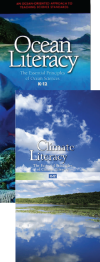Faculty/Graduate Student Collaborative Workshop at the DMC
Workshop Theme: Ocean-Climate Connections |
|
Held at the Darling Marine Center in Walpole, ME
Friday, January 29, 2010 and Monday through Tuesday, February 1-2, 2010 |
|
|
|
Using ocean and climate literacy principles that best align with the research areas of the workshop scientists, applicants are asked to rate their
comfort with and the relevance of the concepts to their own work. Following the workshop, graduate student participants were asked to indicate
whether changes occurred in their comfort with and their sense of the relevance of the same literacy concepts.
Literacy change data are presented in the charts below, color-coded as green ("preferred result"), yellow ("less preferred result"), and red ("negative result").
Our preferred result is: 1) they remained "very comfortable" with a principle or continued to find it "very relevant" after the workshop; or 2) they were "more
comfortable" with a literacy principle or felt it was "more relevant" after the workshop. Our less preferred result is that the workshop failed to increase an
initially moderate "comfort" or "relevance" rating for any principle. We consider any of the following to be a "negative result": 1) a decrease in "comfort" or
"relevance" after the workshop; or 2) their post-workshop status remained either "somewhat" or "not" comfortable / relevant.
The degree to which comfort and relevance changed varied between concepts, some being less emphasized than others at the workshop. The following chart
provides a summary of those results ( download this chart as a PDF [978 KB]).
Use of mathematical models is now an essential part of ocean sciences. Models help us understand the complexity of the ocean and of its interaction with Earth's climate. They process observations and help describe the interactions among systems. |
 |
Ocean habitats are defined by environmental factors. Due to interactions of abiotic factors, ocean life is not evenly distributed temporally or spatially. Some regions of the ocean support more diverse and abundant life than anywhere on Earth, while much of the ocean is considered a desert. |
 |
Organisms survive within specific ranges of temperature, precipitation, humidity, and sunlight. If they are exposed to climate conditions outside this range, they must adapt, migrate, or perish. |
 |
New technologies, sensors and tools are expanding our ability to explore the ocean. Ocean scientists are relying more and more on satellites, drifters, buoys, subsea observatories and unmanned submersibles. |
 |
Ocean biology provides many unique examples of life cycles, adaptations and important relationships among organisms (symbiosis, predator-prey dynamics and energy transfer) that do not occur on land. |
 |
The carbon cycle influences climate in a variety of ways, including seasonal interactions between the atmosphere, biosphere, and hydrosphere, and the formation and consumption of fossil fuels. Carbon dioxide, an important greenhouse gas, is removed from the atmosphere in the ocean and other parts of the Earth system through biologic and geologic processes. |
 |
Over the last 40 years, use of ocean resources has increased significantly; therefore, the future sustainability of ocean resources depends on our understanding of those resources and both their potential and limitations. |
 |
Naturally occurring processes move carbon through the Earth system. Growing plants remove carbon dioxide from the atmosphere. Burning plants (including fossil fuels) release carbon dioxide into the atmosphere. The ocean absorbs atmospheric carbon dioxide. Marine organisms remove carbon dioxide from the ocean, incorporating it into their shells; when the organisms die and their shells settle to the ocean floor, the carbon becomes part of the geosphere. |
 |
Quotes from Workshop Participants
"Ecosystem modelling is often a difficult concept to present. I have learnt that using a simple example that audiences can relate to is an effective way
to communicate this information."
"I learned that the general audience is not very familiar with this concept. It is important to name the factors and processes but also to link them
with case studies and observations people can make themselves in every day life. Analogies to their personal experiences seem very powerful and presently
underestimated in communication of scientific knowledge."
|














